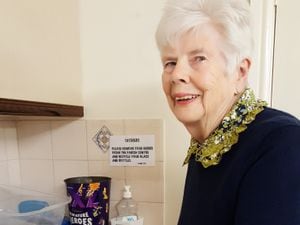'We could lose our NHS': Shropshire campaigner shares horror stories caused by ambulance crisis
A Shropshire ambulance campaigner believes we’re on the brink of 'losing our NHS' as 'shocking' waiting times continue.

It comes after health bosses confirmed Shrewsbury and Telford Hospitals Trust will be taking part in a pilot scheme to try and get ambulances back out onto the road more quickly.
Scenes of several emergency vehicles queuing outside the county’s hospitals has been commonplace this year, causing distress to patients having to wait for hours on end to be treated by doctors.
One patient, Andy Maxwell, told how when he was rushed to Royal Shrewsbury Hospital recently, paramedics told him he was the only patient they dealt with for their entire 12-hour shift.
Campaigner and Ludlow councillor Darren Childs said: “It just gets worse and worse. It’s shocking and disappointing. We’ve always said the NHS is in crisis, but it’s now at the point where we are losing the NHS.
“We’re getting to a point where we’re not going to get back from it.”
On the pilot scheme, he added: “It helps to get the ambulances back on the road, but it doesn’t reduce the time you are waiting in A&E. It doesn’t help with discharging.”
A new national survey today revealed that concerns about bed shortages, emergency response times and poor care quality have risen sharply up the list of health service issues people are most worried about.
Councillor Childs started campaigning after his baby daughter Myla was left waiting 37 minutes for an ambulance when she suffered a seizure in January.
Since then, several people have been in touch with him, sharing their horror stories.
"There was one elderly person who had a bleed on the brain who had to wait seven hours in an ambulance," he said.
"Then they were on a trolley for 12 hours. They were in hospital for three weeks.
"There was an eight-year-old who broke her leg and had to wait for four hours for an ambulance to get to her."
Fresh figures show the distress facing patients to be transferred into A&Es in Shropshire. In the week up to October 27, four consecutive days saw patients waiting in the back of ambulances for more than 10 hours outside Royal Shrewsbury Hospital.
The successive longest wait times from October 22 were 10 hours 36 minutes, 11 hours 32 minutes, 10 hours 28 minutes, and ten hours two minutes.
In total, ambulances spent 562 hours waiting outside Shrewsbury.
At Telford, where the longest wait was seven hours 46 minutes, the total hours lost waiting were 453.
Across both hospitals the longest average wait came at Shrewsbury on October 26, at 144 minutes per person, and at Telford on October 23, at 139 minutes.
The situation means that the number of patients waiting over 15 minutes to be handed over was 312 at Telford, and 250 at Royal Shrewsbury.
This week hospital bosses confirmed that the trust is taking part in a pilot scheme designed to tackle the crisis.
WMAS said that SaTH had signed up to its new pilot, where it is employing staff to work in 'ambulance decision areas' – effectively part of the hospital where ambulance patients can wait and be looked after by dedicated staff, before they can be admitted to A&E.
Mr Childs said the news is "welcome", but only helps one part of the problem.
"It helps to get the ambulances back on the road," he said, "but it doesn't reduce the time you are waiting in A&E. It doesn't help with discharging people.
"I spoke to Mark Docherty (WMAS director of nursing) and he said the pilot had helped reduce waiting times in Birmingham. That's good, but it doesn't solve the whole problem."
Karen Evans, interim deputy chief operating officer at SaTH, said on the pilot scheme: “We will soon be introducing an Ambulance Decision Area at Royal Shrewsbury Hospital.
"This will see a dedicated West Midlands Ambulance Service and SaTH Emergency Department team looking after patients collaboratively in hospital rather than on ambulances, which will help to free up ambulances to respond to new emergency calls.”





